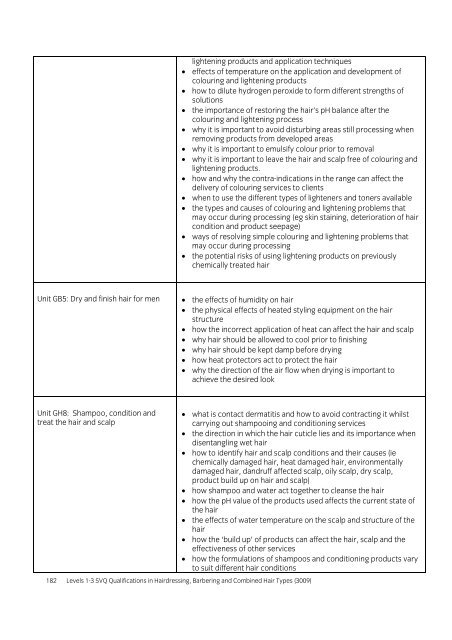3009 SVQ Assessment handbook v2 - City & Guilds
3009 SVQ Assessment handbook v2 - City & Guilds
3009 SVQ Assessment handbook v2 - City & Guilds
Create successful ePaper yourself
Turn your PDF publications into a flip-book with our unique Google optimized e-Paper software.
lightening products and application techniques<br />
• effects of temperature on the application and development of<br />
colouring and lightening products<br />
• how to dilute hydrogen peroxide to form different strengths of<br />
solutions<br />
• the importance of restoring the hair’s pH balance after the<br />
colouring and lightening process<br />
• why it is important to avoid disturbing areas still processing when<br />
removing products from developed areas<br />
• why it is important to emulsify colour prior to removal<br />
• why it is important to leave the hair and scalp free of colouring and<br />
lightening products.<br />
• how and why the contra-indications in the range can affect the<br />
delivery of colouring services to clients<br />
• when to use the different types of lighteners and toners available<br />
• the types and causes of colouring and lightening problems that<br />
may occur during processing (eg skin staining, deterioration of hair<br />
condition and product seepage)<br />
• ways of resolving simple colouring and lightening problems that<br />
may occur during processing<br />
• the potential risks of using lightening products on previously<br />
chemically treated hair<br />
Unit GB5: Dry and finish hair for men<br />
• the effects of humidity on hair<br />
• the physical effects of heated styling equipment on the hair<br />
structure<br />
• how the incorrect application of heat can affect the hair and scalp<br />
• why hair should be allowed to cool prior to finishing<br />
• why hair should be kept damp before drying<br />
• how heat protectors act to protect the hair<br />
• why the direction of the air flow when drying is important to<br />
achieve the desired look<br />
Unit GH8: Shampoo, condition and<br />
treat the hair and scalp<br />
• what is contact dermatitis and how to avoid contracting it whilst<br />
carrying out shampooing and conditioning services<br />
• the direction in which the hair cuticle lies and its importance when<br />
disentangling wet hair<br />
• how to identify hair and scalp conditions and their causes (ie<br />
chemically damaged hair, heat damaged hair, environmentally<br />
damaged hair, dandruff affected scalp, oily scalp, dry scalp,<br />
product build up on hair and scalp)<br />
• how shampoo and water act together to cleanse the hair<br />
• how the pH value of the products used affects the current state of<br />
the hair<br />
• the effects of water temperature on the scalp and structure of the<br />
hair<br />
• how the ‘build up’ of products can affect the hair, scalp and the<br />
effectiveness of other services<br />
• how the formulations of shampoos and conditioning products vary<br />
to suit different hair conditions<br />
182 Levels 1-3 <strong>SVQ</strong> Qualifications in Hairdressing, Barbering and Combined Hair Types (<strong>3009</strong>)
















